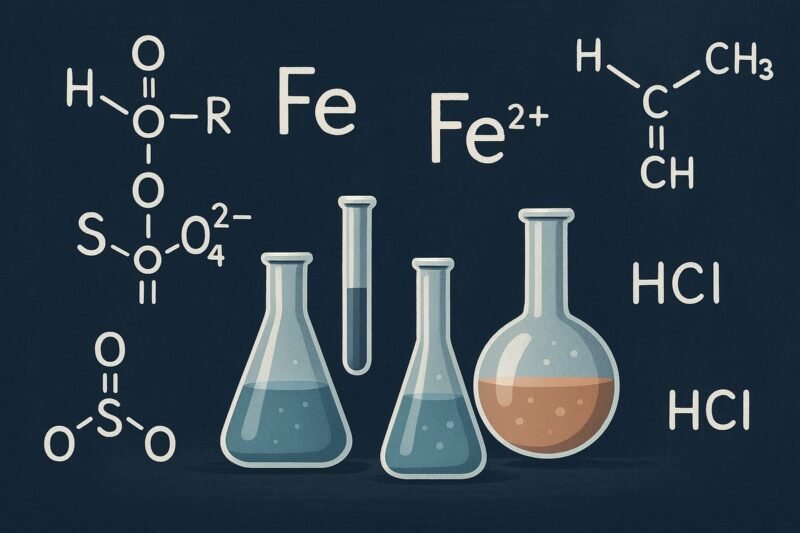The Common Stumbling Block in Chemistry: Which Formula Name Pair is Incorrect?
Navigating the world of chemistry can feel like learning a new language, and one of the first major hurdles is mastering chemical nomenclature. It’s a set of rules for naming the vast number of chemical compounds that exist. For many students, the question, “Which formula name pair is incorrect?” is a familiar and often frustrating sight on exams and homework. It’s a question designed to test your understanding of this chemical language, and it’s easy to get tripped up by the details.
This guide is here to clear up the confusion. We’ll break down the essential rules of chemical naming, shine a light on the most common mistakes, and give you a straightforward, step-by-step method to confidently identify incorrect formula-name pairs. By the end, you’ll be able to tackle these problems with greater accuracy and less stress.
Decoding Chemical Names: The Basic Rules
The Language of Chemistry
At its core, chemical nomenclature is the universal language that allows scientists to communicate with precision. A single, correctly formed name contains a wealth of information, describing the exact elements in a compound and how they are bonded. Getting a firm grip on this language is a crucial first step toward understanding the broader concepts of chemical reactions and material properties.
Ionic vs. Covalent Bonds
Chemical compounds are broadly categorized by the bonds that hold them together, primarily ionic and covalent bonds. While covalent compounds (formed between nonmetals) have their own prefix-based naming system, the most frequent and confusing errors occur with ionic compounds. These compounds, formed between a metal and a nonmetal, involve the transfer of electrons, creating positive and negative ions. Because of their complexity, we’ll focus on the rules for naming these ionic compounds.
Handling Transition Metals
One of the most challenging aspects of ionic nomenclature involves transition metals—elements like iron, copper, and tin. These metals are tricky because they can form ions with different positive charges. To eliminate any ambiguity, chemists use the Stock system, which uses Roman numerals in parentheses to specify the metal’s oxidation state. For example, the compound FeCl₂ is named iron(II) chloride, indicating that iron has a +2 charge. In contrast, FeCl₃ is named iron(III) chloride, signifying an iron ion with a +3 charge.
Unmasking Common Errors in Formula-Name Pairs
The Polyatomic Ion Mix-Up
A very common mistake is confusing polyatomic ions that have similar names but different formulas. These ions are groups of atoms bonded together with an overall charge. A tiny change in spelling can point to a completely different chemical. The most classic example is the family of sulfur-based ions: sulfate (SO₄²⁻), sulfite (SO₃²⁻), and sulfide (S²⁻). A compound with the formula Na₂SO₄ is correctly named sodium sulfate. If it were misidentified as sodium sulfite, it would be an error, as that name corresponds to a different formula entirely.
This confusion also extends to other groups, such as the nitrogen-based ions nitrate (NO₃⁻) and nitrite (NO₂⁻). It is essential to commit the names and formulas of these common polyatomic ions to memory to avoid these easy-to-make mistakes.
Oxidation State Errors
Another frequent pitfall is assigning the wrong oxidation state to the metal, especially when dealing with transition metals. The Roman numeral in the name must accurately reflect the metal’s charge in the compound. For instance, let’s look at FeO. Since the oxide ion (O) has a 2- charge, the iron ion (Fe) must have a +2 charge to balance it. Therefore, its correct name is iron(II) oxide. Naming it iron(III) oxide would be incorrect, as that name belongs to the compound Fe₂O₃.
To avoid this error, always work backward from the anion, whose charge is often fixed and known. This allows you to deduce the correct charge of the metal cation and verify the Roman numeral in the name.
Simple Yet Tricky Naming Conventions
Errors can even pop up in what seem to be simple binary compounds. A common slip-up is mixing up monatomic anions with polyatomic ones. For example, the compound Mg₃N₂ is composed of magnesium ions (Mg²⁺) and nitride ions (N³⁻). Its correct name is magnesium nitride. It is often incorrectly called magnesium nitrite. As a rule of thumb, the “-ide” suffix usually signals a single-element anion, whereas “-ite” and “-ate” are reserved for polyatomic ions that contain oxygen.
A Practical Guide to Identifying Incorrect Pairs
Step 1: Analyze the Formula
Begin by dissecting the chemical formula. Identify the cation (the positive ion, which is usually the metal) and the anion (the negative ion). For example, in the formula Fe₂(SO₄)₃, the cation is iron (Fe), and the anion is the polyatomic sulfate ion (SO₄).
Step 2: Determine the Charges
Next, figure out the charges of the ions. The charges of most common anions are constant. The sulfate ion (SO₄), for instance, always carries a 2- charge. In our example, Fe₂(SO₄)₃, there are three sulfate ions, giving a total negative charge of 3 × (-2) = -6. To create a neutral compound, the two iron ions must have a combined positive charge of +6. This means each iron ion must have a +3 charge.
Step 3: Scrutinize the Name
Now, look closely at the name provided. Does it match what you’ve just figured out from the formula? If the name given for Fe₂(SO₄)₃ is iron(III) sulfate, it correctly identifies the +3 charge on the iron and the sulfate ion. However, if the name were iron(II) sulfate or iron(III) sulfite, it would be an incorrect pairing.
Step 4: Spot the Discrepancy
By comparing your analysis with the given name, you can pinpoint the exact source of the error. Is the Roman numeral incorrect? Is the polyatomic ion named improperly? For instance, if the pair is presented as Fe₂(SO₄)₃ – iron(III) sulfide, the mistake is obvious: the formula contains a sulfate ion, not a sulfide ion.
Conclusion: Building Confidence in Chemical Nomenclature
Getting comfortable with chemical nomenclature is all about precision and practice. That recurring question, “Which formula name pair is incorrect?” isn’t there to trick you; it’s a check on your attention to detail. By understanding the core rules, recognizing the common traps like polyatomic ion mix-ups and oxidation state errors, and using a methodical approach, you can build the skill and confidence to ace these questions.
Remember, every letter and number in a chemical name and formula has a distinct and important meaning. With a bit of practice, the language of chemistry will become more familiar, and you’ll be able to navigate the complex world of chemical compounds with much greater ease and accuracy.









